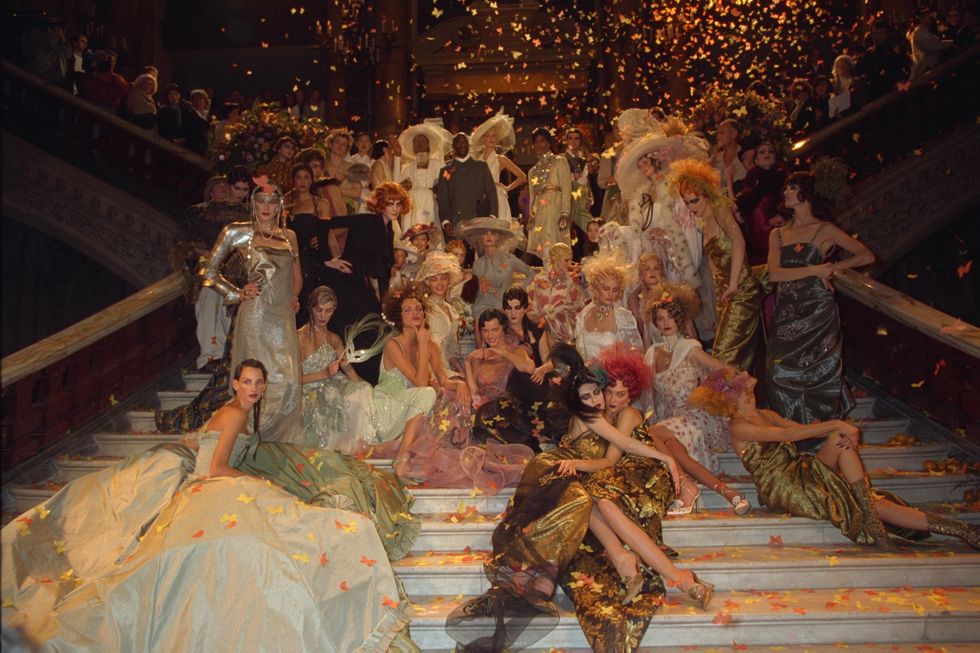
Ralph Toledano on Why Paris Is Flourishing in Fashion, Culture, Tech – WWD
[ad_1]
The buzz is coming back — online and IRL.
Paris Men’s Fashion Week is in full swing, declared officially open on Tuesday via a spirited video address from “Schitt’s Creek” star Dan Levy. Travis Scott is in town to unveil a collaboration with Kim Jones at Dior, one of a handful of brands holding live runway spectacles with real audiences. Editors and influencers from across Europe have trickled back into the French capital for the first time in about 15 months as pandemic-related restrictions ease on a good swath of the continent.
On the heels of the men’s wear showcase is one of the newsiest haute couture weeks in decades, which has Ralph Toledano smiling. The president of the Fédération de la Haute Couture et de la Mode spoke to WWD about the resilience of the French fashion industry, the effervescent cultural scene in Paris and why haute couture is flourishing.
WWD: Like most European countries, France endured long and difficult lockdowns. How would you describe the industry reactivity?
Ralph Toledano: We have to pay a huge tribute to the French fashion industry for its spontaneous and impressive efforts to fight the pandemic and its financial consequences. Amid shortages of face masks and sanitizing gel, the industry converted its facilities to produce them freely. In addition, the biggest luxury groups turned down the financial help offered by the government support plan, notably in terms of furlough indemnities.
On the business side, the reactivity and the resilience of French fashion brands have been impressive. Whereas in other countries, a lot of companies have disappeared with a high number of jobs eliminated, the French fashion industry has come out of the crisis stronger than ever, and ready to embrace the new growth opportunities.
Companies have reviewed their offer, downsized their collections, adapted them to new needs and adjusted pricing. They digitalized their activities in an extremely fast way, strengthening their direct relationship with the customer. They took advantage of their strong presence, and performed exceptionally well in the only growing markets in the world — Asia Pacific and, notably, China. Sustainability has also become a top priority, and even if there is a long way to go, our sector is now focused on the task.
WWD: Paris took the lion’s share of attention for the women’s fall 2021 shows, with a media impact value $132 million. Those Launchmetrics tallies put Paris ahead of Milan, and dwarf smaller fashion weeks in New York and London. What does the data tell you?
R.T.: Data shows how strong the impact of creative videos has been. Digitalization spawned new areas for creativity and opened the doors of fashion to the final costumer all over the world. It has been a giant step.
WWD: How will Paris Fashion Week maintain its stature as the most important fashion capital, physical and digital?
R.T.: The same selection criteria have been applied for the participants since 1868 for haute couture and 1973 for ready-to-wear: creativity, craftsmanship and internationalization. We will continue using the same guidelines, which have made Paris the indisputable fashion capital of the world. It is now also the fashion capital in the digital world. Our position has lately been strongly reinforced by the support of public powers. I’m referring to Paris Mayor Anne Hidalgo, who has met with editors and helps us with show venues, as well as French President Emmanuel Macron, who has welcomed designers to the Élysée Palace for gala events, spending time with the city’s creative movers and shakers.
WWD: This men’s week, and the forthcoming haute couture week in particular, feature an encouraging number of physical shows. Do you expect a full return to live fashion weeks soon?
R.T.: We expect a total return to physical shows in September, as long as the health situation continues to improve. Press, buyers, designers and fashion professionals in general can’t wait to resume physical shows. Digital events cannot replace them: The full expression of creative fashion requires a real-life emotion. But the industry will now also benefit from the creative digital power. Digital tools, notably videos and livestreaming, will generate a considerable amount of content for the brands to communicate with their communities.
WWD: What’s the future of the federation’s digital platform?
R.T.: The digital platform that we have set up with Launchmetrics has been very successful and we will keep on developing it. We have already started doing that this season, introducing NFTs and augmented reality. The platform is also inseparable from the media partnerships that we have built up, in particular with YouTube, Canal and now Tencent. We will continue to enrich this global ecosystem with our members.
WWD: Most fashion weeks, including Paris, splintered during the pandemic, with several major brands showing on their own calendar now. How will the federation entice them back?
R.T.: First, let me state that the huge majority of our brands have followed our decision to release their videos at exactly the same slots as pre-COVID-19. A very limited number of brands did not for different reasons: delays in industrial production; post-production schedules after shooting videos, etc., but as soon as physical fashion weeks will get back, these impediments will naturally vanish.
WWD: The see now, buy now model seems to be gaining currency again. How does the federation feel about it?
R.T.: When this model was suggested, we stated very clearly that it could work for strictly marketing-driven brands, but absolutely not for creative brands. Time has shown that we were right.
WWD: Do fashion weeks still have professional resonance, in your view, or are they becoming pure consumer events?
R.T.: The rationale of fashion weeks is more legitimate than ever. Ask any professional — they will all tell you how impatient they are to go back to the pre-COVID-19 fashion weeks. Virtual showrooms, for example, were extremely helpful during lockdowns, but buyers will tell you that they are often disappointed by what they receive just because they could not see, touch and evaluate the silhouette or the fit of a physical sample in person. They could not meet face to face with their vendors either, and those moments are essential to build a mutually profitable relationship.
On the other side, the digital tools have proven extremely effective to reach out to the final client, which is critical for the success of our brands. Being in touch with your community, being able to communicate your purpose and your values, and assemble a strong data base is indispensable for the brands.
WWD: Paris is brimming with new cultural venues, retail attractions and scores of new restaurants and galleries. How do you explain this explosion of new energy, and how is the federation seizing on it?
R.T.: There is now a huge entrepreneurial and cultural energy in France, which is the most attractive European country for investment. Almost 1 million companies of all types have been created in France in 2020 and the tech and start-up scene is flourishing, as was shown at the successful VivaTech event recently. Fashion and luxury are at the heart of the Parisian identity.
The great initiatives emerging now in Paris will strengthen its economic and cultural power. Paris Fashion Week as a major global event will benefit from this enriched ecosystem and at the same time contribute to its success.
WWD: I understand the federation is stepping up its efforts around emerging designers. Can you elaborate on this and explain how they fit into the ecosystem?
R.T.: The federation has a department dedicated to emerging brands, which brings its expertise in every single aspect of fashion management. Sphere offers a showroom for these brands at every fashion week, and it is now running at full speed. For the last seasons, we put in place a virtual showroom through a collaboration with Le New Black.
Last September, we also created a fashion fund to financially support emerging brands during this pandemic crisis, and I thank very warmly the fund contributors, including the big French brands. We have a committee that decides how to dispense the money, and we’ve helped between 25 and 30 designers per season. Emerging talents are the future of fashion, either by working for existing brands or by starting their own companies. We are therefore committed to support them.
WWD: Paris Fashion Weeks have always been a platform for talents from around the world. How are the upcoming men’s and couture weeks stacking up in this regard?
R.T.: The selection of newcomers, as well as the exit of previously invited brands, are decided by industry experts committees chaired by the president of each Chambre Syndicale. The current men’s and upcoming haute couture weeks will be transitional, as they are mixes of digital events, physical shows held in Paris as well as shows taking place abroad because of the COVID-19 crisis. The majority of the presentations will still be digital. In total, we will have 72 houses for men’s wear and 34 for haute couture.
WWD: People have been predicting the end of haute couture for years, yet here we have a calendar brimming with new names. How do you explain this?
R.T.: Some people, notably the late Pierre Bergé, predicted that haute couture would die. Time showed that they were wrong and haute couture remains a major and distinctive pillar of French fashion. In a world more and more digitalized and profoundly transformed by AI, it represents the highest degree of human know-how and creativity.
Economic factors explain the strength of haute couture. Since the 1980s with the inception of the Reaganomics in the U.S., the globalization of the economy has, in the Western world, made the rich people wealthier and the number of high-net-worth individuals higher. The fall of the Berlin Wall sparked an impressive growth in Eastern Europe, and yielded a substantial number of ultra-wealthy people, notably from Russia. Finally, the extraordinary development of Asia Pacific and China, especially, brought a large group of new high-income customers. At the same time, sales in the Middle East kept growing.
The offer has also improved and expanded. The most prestigious fashion houses and heritage brands have heavily invested in haute couture as it is a unique laboratory for rtw, an exceptional vehicle in terms of image and a profitable business for the major players. Haute couture entices designers wanting to express freely their creativity, discover the possibilities offered by new technologies and new sustainability practices. Each season, the federation receives an impressive amount of applications for admission in the haute couture calendar.
SEE ALSO:
Paris Couture Week Will Feature Eight Runway Shows
Launchmetrics: Paris Remains Capital of Fashion, Digital or Otherwise
[ad_2]
Source link






 We use cookies to optimize our website and our service.
We use cookies to optimize our website and our service. 

Responses